Though a founding concept of ecology suggests that the physical environment determines where organisms can survive, modern scientists have suspected there is more to the story of how microbial communities form in the soil.
Though a founding concept of ecology suggests that the physical environment determines where organisms can survive, modern scientists have suspected there is more to the story of how microbial communities form in the soil.
In a new study, researchers have determined through both statistical analysis and in experiments that soil pH is a driver of microbial community composition—but that the need to address toxicity released during nitrogen cycling ultimately shapes the final microbial community.
«The physical environment is affecting the nature of microbial interactions, and that affects the assembly of the community», said co-lead author Karna Gowda, assistant professor of microbiology at The Ohio State University. «People in the field understood these two things must be important at some level, but there wasn’t a lot of evidence for it. We’re adding some specificity and mechanisms to this idea.»
The work helps clarify the microbial underpinnings of global nitrogen cycling and may provide a new way to think about emissions of nitrous oxide, a potent greenhouse gas, Gowda said.
The research was published recently in Nature Microbiology.
Microbes keep soil healthy and productive by recycling nutrients, and are particularly important for converting nitrogen into forms that plants can use. Underground organisms living in the same environment are also highly interconnected, preying on each other, participating in chemical exchanges and providing community benefits.
Домой
United States
USA — IT Soil pH drives microbial community composition: Study shows how bacteria work together...






